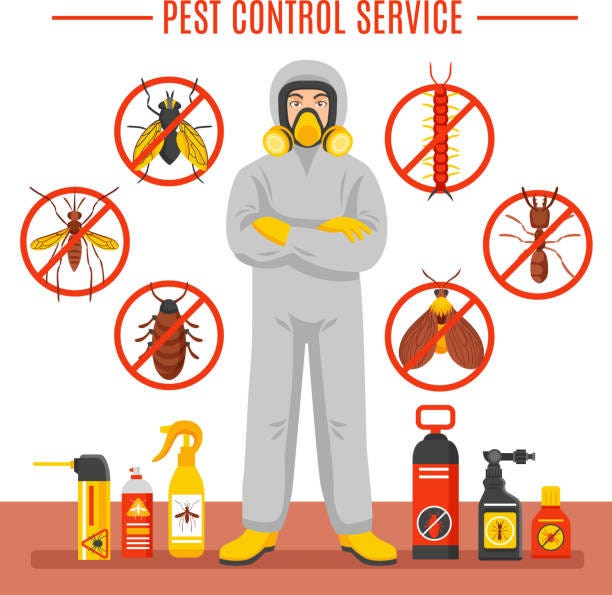Bed Insect Therapy Malfunction: Contrasting Chemical Vs. Non-Chemical Solutions
In the realm of bug control, particularly when dealing with the persistent problem of bed insects, the choice between chemical and non-chemical treatment solutions can be an essential one. Both techniques use unique advantages and drawbacks, influencing factors such as performance, security factors to consider, and total expense. By taking a look at the nuanced information of each method, a more clear understanding of which path to seek in resolving a bed bug infestation can be obtained.
Performance of Chemical Treatments
Chemical treatments for bed bug problems have actually been commonly recognized for their quick and potent effectiveness in getting rid of these pests. When thinking about the performance of chemical therapies, it is important to comprehend that they can give a extensive and quick option to a bed insect trouble. Specialist pest control men typically depend on insecticides to target bed pests at numerous phases of their life cycle, including eggs, grownups, and nymphs. These chemicals typically function by interrupting the bed pests' nervous system, leading to paralysis and eventual fatality.
Additionally, chemical treatments have the benefit of using residual results, suggesting that they can remain to eliminate bed bugs also after the preliminary application. This residual action is specifically advantageous in combating any prospective re-infestations. Additionally, the quick action of chemical therapies can bring relief to individuals facing serious bed pest invasions, allowing them to reclaim control of their home swiftly.
Security Worry About Chemical Solutions
One crucial aspect that requires cautious factor to consider when utilizing chemical remedies for bed pest treatment is ensuring the safety and security of occupants and the atmosphere. Direct exposure to specific chemicals utilized in bed pest therapies can lead to respiratory system concerns, skin inflammation, or other damaging responses, particularly in individuals with pre-existing problems or sensitivities.
Moreover, the ecological effect of chemical services is one more considerable consideration. Some pesticides used in bed bug therapies may be damaging to valuable pests, wildlife, and ecological communities if they seep into the dirt or water supply. It is necessary to make use of chemical therapies judiciously, adhering to security guidelines, and thinking about less harmful options to mitigate these threats and ensure the secure and effective administration of bed pest infestations.
Benefits of Non-Chemical Techniques
Thinking about the potential safety issues and ecological influence related to chemical remedies for bed insect treatment, discovering non-chemical approaches provides an encouraging alternative with a number of unique benefits. Non-chemical techniques supply a much safer choice for houses, especially those with pets, individuals, or children conscious severe chemicals. These techniques get rid of the dangers of direct exposure to poisonous substances, decreasing the potential for unfavorable health results. Additionally, non-chemical treatments are eco-friendly, as they do not add to air or water pollution, making them a sustainable selection for bug control.
Additionally, non-chemical solutions can be effective in targeting bed bugs, including hard-to-reach areas where chemical treatments may not penetrate. Methods such as heat treatment, vacuuming, heavy steam cleaning, and mattress coverings offer extensive removal without making use of dangerous chemicals. Furthermore, non-chemical approaches can be much less turbulent, requiring marginal prep work and permitting quicker reentry into dealt with locations. Generally, going with non-chemical bed insect treatment approaches not only focuses on security and environmental management but also ensures efficient and extensive pest control.
Limitations of Non-Chemical Treatments

Additionally, non-chemical treatments typically call for numerous applications to accomplish effective removal. This can be taxing and may not always ensure full elimination of all bed insects and their eggs, specifically in surprise or hard-to-reach locations.
Moreover, the success of non-chemical treatments heavily relies upon correct implementation and thoroughness, which can be challenging for individuals without expert proficiency. Inadequate application of non-chemical techniques may cause insufficient resource eradication, causing persistent infestations and the demand for added treatments.
Consequently, while non-chemical therapies have their benefits, it is vital to acknowledge these restrictions and consider them when determining the most effective technique for taking care of bed pest infestations.
Expense Contrast: Chemical Vs. Non-Chemical Options
Given the restrictions connected with non-chemical therapies, a vital aspect to assess in the context of bed insect management is the cost comparison in between chemical and non-chemical options. In contrast, non-chemical therapies like heat treatment or heavy steam can be much more expensive, with costs ranging from $1,000 to $6,000 for a whole home. While the first price of chemical therapies might appear reduced, several treatments might be required to completely eliminate the invasion, possibly increasing the general price.
Conclusion

Considering the prospective safety and security issues and ecological influence associated with chemical remedies for bed bug treatment, discovering non-chemical techniques offers an encouraging alternative with a number of distinctive benefits.Given the restrictions linked with non-chemical therapies, an essential aspect to review address in the context of bed bug administration is the price comparison between chemical and non-chemical choices. In contrast, non-chemical therapies like heat therapy or heavy steam can be more costly, with costs varying from $1,000 to $6,000 for a whole home. While the preliminary price of chemical treatments might appear lower, numerous treatments might be called for to totally get rid of the problem, possibly raising the total price.In conclusion, when comparing chemical and non-chemical bed bug treatment choices, it is crucial to consider efficiency, security, advantages, constraints, and cost.